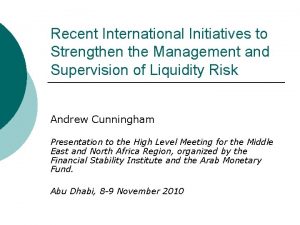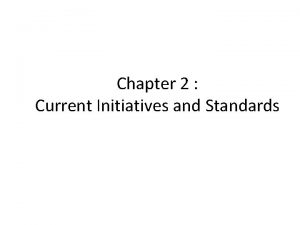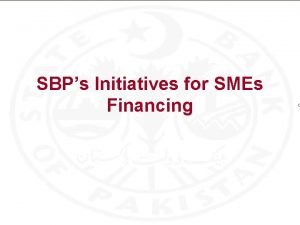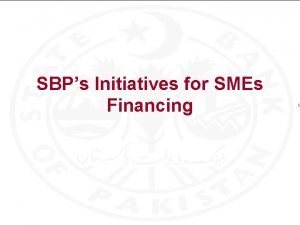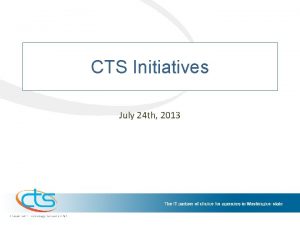Recent International Initiatives to Strengthen the Management and
















- Slides: 16

Recent International Initiatives to Strengthen the Management and Supervision of Liquidity Risk Andrew Cunningham Presentation to the High Level Meeting for the Middle East and North Africa Region, organized by the Financial Stability Institute and the Arab Monetary Fund. Abu Dhabi, 8 -9 November 2010

Outline of the Presentation ¡ Examples of liquidity regulations introduced by national supervisors. ¡ Examples of supra-national initiatives on liquidity. (The BCBS proposals are being addressed in a separate presentation. ) ¡ Examples of initiatives being taken in the Middle East. ¡ General themes and ideas contained in recent regulations and initiatives.

U. K. Financial Services Authority (1) ¡ Policy Statement 09/16 issued in October 2009 concluded review of U. K. framework for liquidity regulation which began in 2007. ¡ New Liquidity Standards for most banks, building societies and investment firms effective as “BIPRU 12” in 1 December 2009. * ¡ Two-tier regime: Standard ILAS BIPRU firms Simplified ILAS BIPRU firms ¡ Provision also made for Non-ILAS BIPRU firms (Consultation Guidance published October 2010) * BIPRU = Prudential Sourcebook for Banks, Building Societies and Investment Firms, in contrast to, e. g. , “GENPRU”: General Prudential Sourcebook, or “INSPRU”: Prudential Sourcebook for Insurers.

U. K. Financial Services Authority (2) ¡ BIPRU 12. 2. 1 Overall Liquidity Adequacy Rule l ¡ “A firm must at all times maintain liquidity resources which are adequate, both as to amount and quality, to ensure that there is no significant risk that its liabilities cannot be met as they fall due. ” BIPRU 12. 3: Liquidity Risk Management l Requirements related to systems, controls and management of liquidity risk, (including responsibility of the board); and provisions related to specific areas such as liquidity pricing and management of collateral. ¡ BIPRU 12. 4: Stress Testing and Contingency Funding ¡ BIPRU 12. 5: Standard ILAS BIPRU firms conduct Individual Liquidity Adequacy Assessments (ILAA) which address: l l l ¡ A name-specific liquidity stress lasting two weeks A market-wide liquidity stress lasting three months Simultaneous occurrence of both of the above BIPRU 12. 6: Simplified ILAS BIPRU firms must l l comply with a “simplified buffer requirement” and submit an Individual Liquidity Systems Assessment (ILSA) detailing compliance with BIPRU 12. 3 and BIPRU 12. 4.

U. K. Financial Services Authority (3) ¡ BIPRU 12. 7: defines nature of assets which may be used in a liquidity buffer. ¡ BIPRU 12. 8 recognises that in some circumstances it may be appropriate for a firm to rely on (a) resources available by other members of its group or (b) resources elsewhere within the firm. Firms may apply for: l l ¡ An intra-group liquidity modification, or A whole-firm liquidity modification (“modification” = modification to the “Overall Liquidity Adequacy Rule” expressed in BIPRU 12. 2) BIPRU 12. 9: Taking into account, inter alia, a firm’s ILAA, the FSA will issue “Individual Liquidity Guidance” (ILG) to all Standard ILAS firms and may issue ILG to Simplified firms. ILG will address: l l The amount and quality of liquidity resources The prudence of a firm’s funding profile

Reserve Bank of New Zealand ¡ “Liquidity Policy” (Document “BS 13”) issued March 2010 and effective from 1 April 2010. ¡ Includes quantitative and qualitative requirements. ¡ Quantitative requirements are prescriptive: l l l ¡ one week mismatch ratio one month mismatch ratio one year core funding ratio (CFR) CFR requires banks to fund 65% of loans from either retail deposits or long-term wholesale funding (> one year). Ratio to rise to 70% and 75% by mid 2012. RBNZ recognizes that, to meet the CFR, banks will need to adjust funding profiles and that the system may have to develop new funding products such as covered bonds.

U. S. Regulators: Interagency Policy Statement (1) ¡ Interagency Policy Statement on Funding and Liquidity Risk Management, issued March 2010 and effective May 2010. ¡ Summarises the principles of liquidity risk management issued in the past and, where appropriate, harmonizes them with the Basel committee’s September 2008, “Principles. ”

U. S. Regulators: Interagency Policy Statement (2) ¡ Principles based approach: l ¡ E. g. The sections entitled, “Stress Testing” (IV. 18) and ”Contingency Funding Plan” (IV. 31) do not prescribe specific scenarios (e. g. “loss of market access for 30 days. ”) Firms must maintain liquidity at both a consolidated and at the level of all “significant legal entities. ” (Comment: This may increase the incidence of “trapped pools of liquidity” but may also make individual legal entities safer. )

Swiss Financial Market Supervisory Authority (Finma) and Swiss National Bank (SNB) ¡ New liquidity regime for Swiss big banks (Credit Suisse and UBS) came into force on 30 June 2010. ¡ Core element of the new regime is a stress scenario entailing a general crisis in financial markets and a loss of trust in the individual bank. Banks must have a reserve of first-class liquid assets able to cover outflows over at least 30 days. ¡ The new requirements have countercyclical elements, allowing liquidity to be accumulated during periods of strong economic growth and drawn down during times of stress.

Committee of European Banking Supervisors (CEBS) (1) ¡ “Guidelines on Liquidity Buffers and Survival Periods” published in December 2009. ¡ Follows up on CEBS’s September 2008 document, “Advice to the European Commission on liquidity risk management” and in particular its Recommendation 16 which referred to the need for robust liquidity buffers. ¡ The Guidelines are directed at banks’ internal risk management processes, but CEBS says that they may be useful for the purpose of supervisory review. ¡ There are six Guidelines. ¡ CEBS says that implementation of the Guidelines will entail a “significant strengthening of firms’ liquidity positions”. CEBS notes the need to take into account the broad economic climate and the need to avoid placing unnecessary constraints on bank lending. ¡ CEBS expects its members to ensure firms comply with the Guidelines by 30 June 2010.

Committee of European Banking Supervisors (CEBS) (2) ¡ A liquidity buffer is shaped in three dimensions: 1. the severity and characteristics of the stress scenarios; 2. the time horizon over which the stress lasts ¡ Institutions should apply three types of stress scenarios: 1. idiosyncratic; 2. market specific and 3. a combination of 1 and 2. Note that 3 is not just a combination of 1 and 2. It is possible that 3 > (1+ 2) or that 3< (1 + 2). ¡ A survival period of at least one month should be applied to the stress scenarios and, within this, a survival period of at least one week should be considered, reflecting the need for a higher degree of confidence over the very short term. ¡ For any given maturity scenario, banks should calculate expected outflows and expected in flows. Where outflows > inflows, the gap needs to be filled either with “counterbalancing capacity” or with excess flows carried over from other periods. ¡ “Counterbalancing capacity” includes – but is much broader than – the liquidity buffer. It includes not only access to excess liquidity but also, e. g. recourse to new funding sources or changes to the business model. ¡ Idiosyncratic stress scenarios should assume an outflow of retail deposits. ¡ Liquidity buffers should not assume changes by central banks to their eligibility criteria and should also take account of regulatory requirements.

IMF Global Financial Stability Report, October 2010 ¡ “ The crisis exposed a bank-centric rather than a systemic approach to liquidity risk management by supervisors. ” l l ¡ Role and influence of non-bank funding sources (e. g. U. S. money market funds) were underestimated Potential for idiosyncratic risks (e. g. U. S. sub-prime credit risk) to translate into system-wide liquidity risk was underestimated. The IMF’s report focuses heavily on the growth and role of money market funds within the financial system, and also on the growth and functioning of repo markets.

Examples of Initiatives by Middle East Regulators ¡ In July 2010, the Central Bank of Bahrain issued a second consultation paper on liquidity risk management for conventional banks. The second consultation paper proposed relaxing to 80% (from 75%) the maximum loan/deposit ratio, and removing the Net Stable Funds requirements (in line with the Basel delay on this point). ¡ The Saudi Arabian Monetary Agency expects to issue new regulations in line with the BCBS approach once the BCBS makes final decisions on the liquidity coverage ratio and the net stable funding ratio. ¡ Bankers in the UAE are expecting the Central Bank of the UAE to start consultations soon regarding the introduction of a new liquidity regime. ¡ Banque du Liban and the (Lebanese) Banking Control Commission had developed a daily liquidity reporting model for local banks before the recent financial crisis (as a result of external shocks such as the assassination of P. M. Harriri in 2005). Following the issuance of the Proposals to Strengthen the Resilience of the Banking System by the BCBS in December 2009, the authorities are developing a comprehensive framework for the measurement of banks’ liquidity risk.

Key Themes of Recent Initiatives ¡ Liquidity management explicitly inserted into expectations of board of directors’ oversight ¡ Liquidity management at the level of the regulated/legal entity rather than at the group level. ¡ Definitions of what is a “liquid” asset are being made more explicit. ¡ Distinction between contractual obligations and behavioral expectations. ¡ Consideration of the functioning of financial markets (e. g. repo markets) and systems (e. g. clearing systems).

Final thoughts: three dimensions of the crisis ¡ “The liquidity we thought we had…we hadn’t” For example: l Liquidity you thought you could get from other entities within your group turned out to be trapped l High quality assets did not yield 100 cents/$ l Contractual obligations did not reflect the way people behaved ¡ “The way we thought markets behaved…they didn’t” For example: l “Off-balance sheet” became “on balance sheet” l The third party repo market froze l Collateral valuations and margin calls pushed firms into crisis ¡ What we thought was the ‘financial system’…wasn’t” For example: l Money market funds in the U. S. had far more influence than we thought they would l The behaviour of hedge funds had huge impact on day-to-day financial intermediation.

Andrew Cunningham andrew@darienmiddleeast. com www. darienmiddleeast. com
 Recent trends in indian foreign trade
Recent trends in indian foreign trade It software management initiatives
It software management initiatives What do you think was askia’s greatest accomplishment?
What do you think was askia’s greatest accomplishment? Hebrews 12:12-13 the message
Hebrews 12:12-13 the message How did cardinal richelieu strengthen the french monarchy
How did cardinal richelieu strengthen the french monarchy Foundation synoynm
Foundation synoynm Recent trends in project management
Recent trends in project management Delvic sanitation initiatives
Delvic sanitation initiatives Digital initiatives in higher education
Digital initiatives in higher education Crm marketing initiatives
Crm marketing initiatives Robert vischer empathy theory health and social care
Robert vischer empathy theory health and social care Business development initiatives
Business development initiatives People's initiatives
People's initiatives Health initiatives
Health initiatives Help desk improvement plan
Help desk improvement plan Us soccer player development initiatives
Us soccer player development initiatives Global health initiatives meaning
Global health initiatives meaning

















